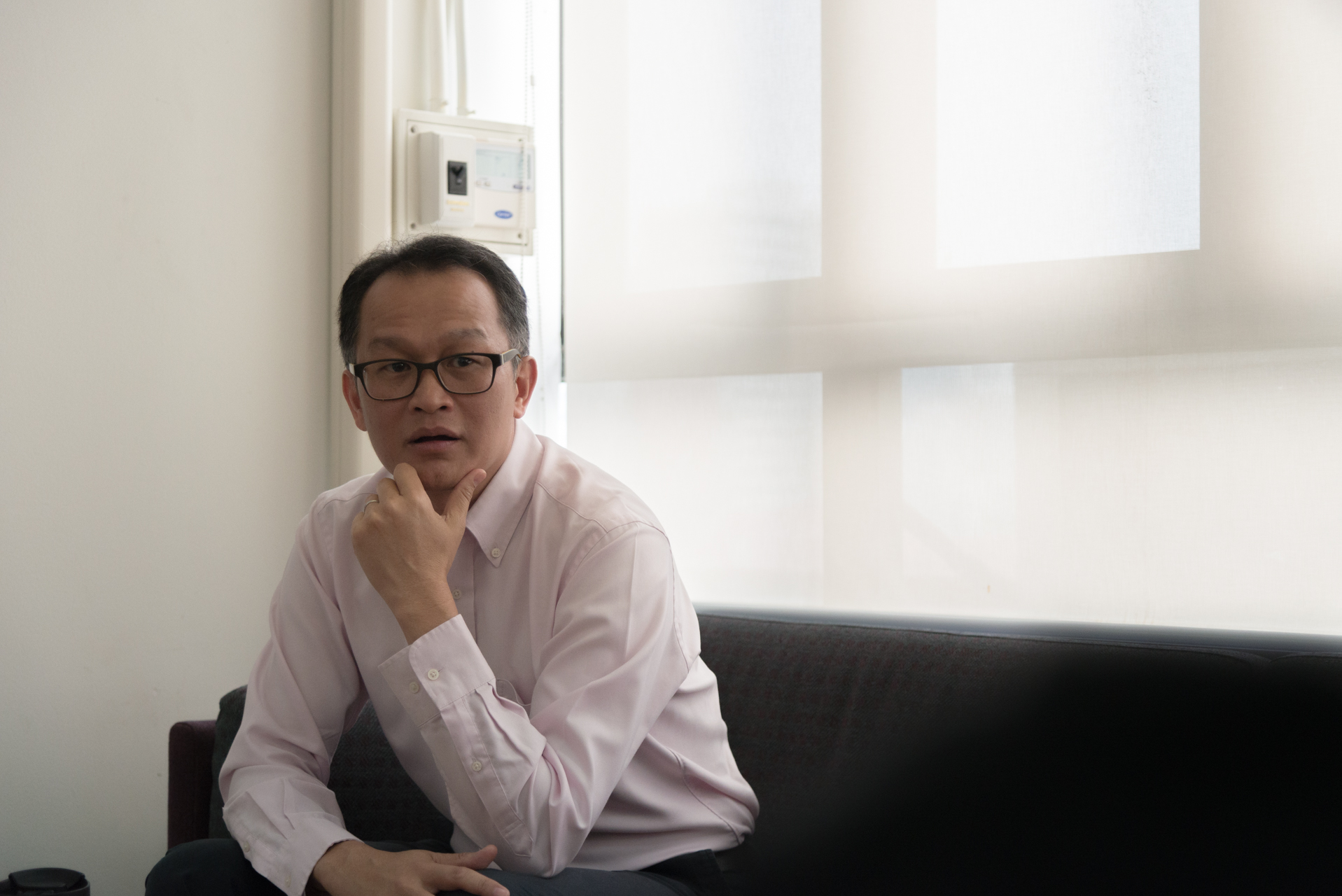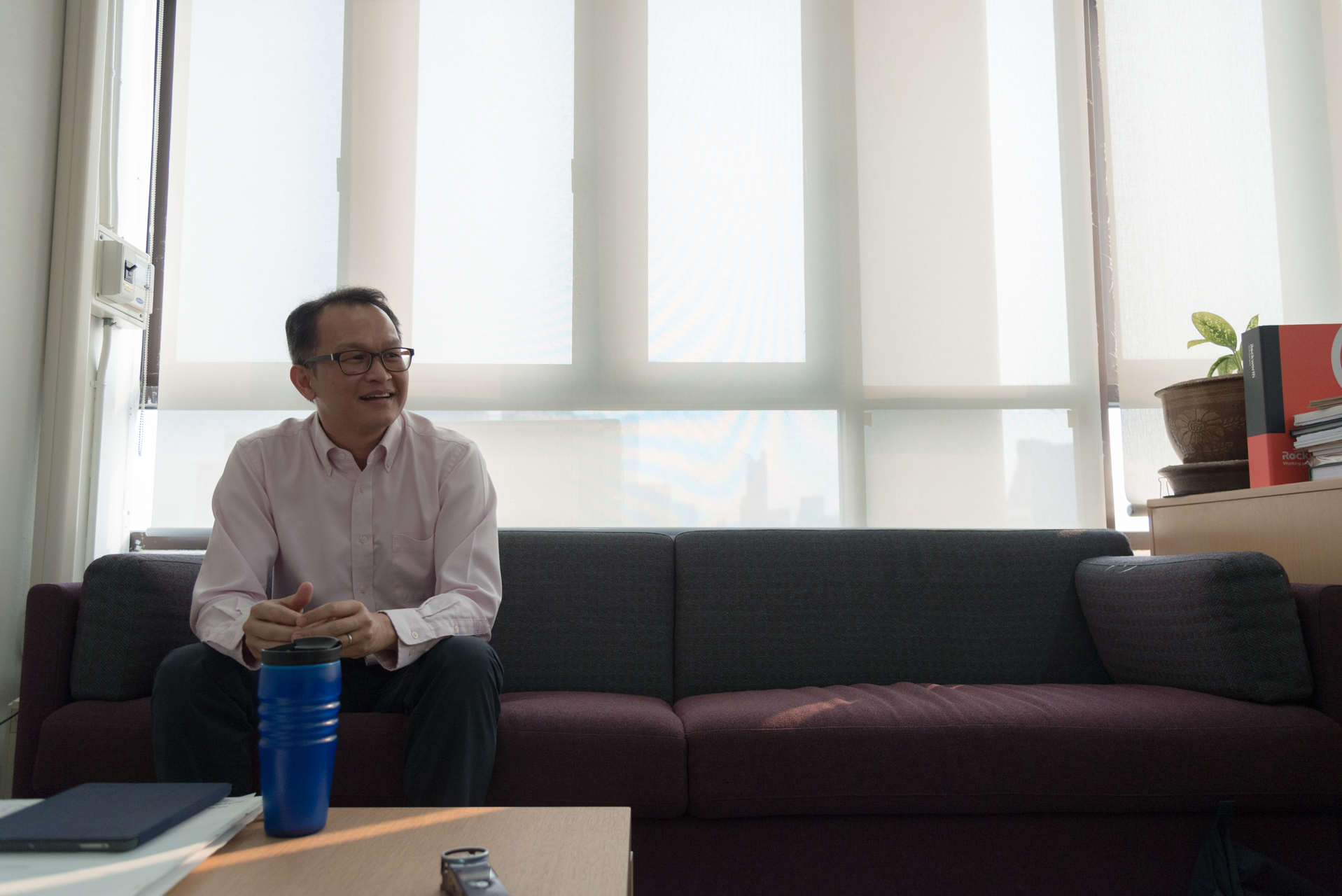ART4D SPEAKS WITH ASSOC. PROF. DR. APIWAT RATANAWARAHA ABOUT HIS CURRENT RESEARCH ON THE TOPIC OF, WHAT WE WOULD CALL, ‘THAI URBANITES 4.0’ WHICH REVOLVES AROUND URBAN RESEARCH, FUTURE RESEARCH, AND URBAN OBSERVATORY AND ENGAGEMENT
INTERVIEW BY KANOKWAN TRAKULYINGCHAROEN AND PAPHOP KERDSUP
PORTRAIT : NAPAT CHARITBUTRA
(For English, please scroll down)
คอลัมน์ CRITICAL ครั้งนี้เราชวน รศ.ดร. อภิวัฒน์ รัตนวราหะ จากภาควิชาการวางแผนภาคและเมือง คณะสถาปัตยกรรมศาสตร์ จุฬาลงกรณ์มหาวิทยาลัย มาพูดคุยถึงงานวิจัยใหม่ล่าสุด “คนเมือง 4.0” และที่มาที่ไปของงานวิจัยชิ้นนี้ ที่เกิดจากการประสานสามส่วนพื้นฐานเข้าด้วยกันนั่นคือ งานวิจัยเมือง (Urban research) กับอีกส่วนหนึ่งที่เรียกว่า งานวิจัยด้านอนาคตศึกษา (Futures research) และงานสังเกตการณ์และขับเคลื่อนการเปลี่ยนแปลงในเมือง (Urban Observatory & Engagement) สำหรับบทความฉบับออนไลน์ชิ้นนี้ เราคัดเลือกบางส่วนมาให้อ่านกันเป็น teaser ก่อน เป็นเหมือนบทนำไปสู่คำถามที่ว่า “อะไรคือนิยามของคำว่า เมือง (city) คนเมือง (urban man) และความเป็นเมือง (urbanisation)” และไปจบตรงคำถามว่า “ตัวตน (self) ของเมืองมีอยู่จริงหรือไม่?” ทั้งหมดนี้จะอยู่ใน art4d No.266 ที่จะตีพิมพ์ในช่วงกลางเดือนมีนาคมที่จะถึงนี้

art4d: ตอนนี้กำลังทำงานวิจัยเกี่ยวกับประเด็นอะไรบ้าง
Apiwat Ratanawaraha : มีเยอะ วันนี้เราคุยกันเฉพาะเรื่องที่เกี่ยวกับเรื่องชีวิตเมืองในอนาคตก็แล้วกันนะครับ เรื่องเมืองเป็นงานที่ผมทำอยู่ปกติ แต่เรื่องที่ผมกำลังจะเริ่มทำอีกงานหนึ่งและเริ่มวิเคราะห์มาได้ระยะนึงแล้ว เป็นโปรเจ็คต์ชื่อ “คนเมือง 4.0: อนาคตชีวิตเมืองในประเทศไทย” เป็นงานหนึ่งในโปรแกรมวิจัยในภาพใหญ่ที่ชื่อว่า คนไทย 4.0 แต่ผมจะทำเฉพาะส่วนที่พูดถึง “คนเมือง 4.0” (Urbanites 4.0)
เรื่องนี้ผมสนใจมานานพอสมควรแล้ว ตัวผมเองก็เคยทำงานเชิงอนาคตศึกษา (futures studies) มาบ้าง แต่ครั้งนี้จะทำจริงๆ จังๆ มากขึ้น โดยปกติ เวลาเรามองหรือวางแผนอะไรต่างๆ เรามักจะมองจากปัญหาเป็นหลัก เช่น เรื่องฝุ่นที่เกิดขึ้นมา มันเกิดจากอะไร สาเหตุมันเกิดจากอะไรอย่างนี้ ที่ผ่านมาความรู้เกี่ยวกับการวางแผน โดยมากมักจะเป็นความรู้จากในอดีตกับปัจจุบัน แต่ในความเป็นจริงแล้ว มันมีความหมายไปถึงว่า เราจะใช้ความรู้เกี่ยวกับอนาคตได้ยังไงด้วย ถึงแม้ว่าอนาคตมันยังไม่เกิด และก็ไม่มีข้อมูลเกี่ยวกับอนาคต แต่ว่าอนาคตศึกษา เป็นกรอบความคิดและวิธีวิทยาแบบหนึ่ง ที่จะทำให้เราสามารถใช้ข้อมูลจากอดีต ปัจจุบัน รวมถึงความเป็นไปได้ที่อาจจะเกิดขึ้นในอนาคตมาเตรียมตัวเพื่อที่จะรับมือกับสิ่งที่จะเกิดขึ้นในอนาคต ซึ่งมันจะมากกว่าการดูแค่ว่า แนวโน้มที่ผ่านมามันเป็นยังไง นี่ก็คือสิ่งที่ผมพยายามเริ่มทำอยู่
ดังนั้นในงานวิจัยที่กำลังจะทำเรื่อง “คนเมือง 4.0” มันเป็นการเชื่อมงานวิจัย 2 ส่วนเข้าด้วยกัน ส่วนที่เรียกว่างานวิจัยเมือง คือ urban research กับอีกส่วนหนึ่งที่เรียกว่า futures research และมีองค์ประกอบที่ 3 ด้วย เรากำลังจะทำเป็น หน่วยสังเกตการณ์เมืองและการชวนคนให้มาร่วมคิดร่วมทำ (Urban Observatory & Engagement) เพื่อผลักดันการเปลี่ยนแปลงของเมือง ตอนนี้เราค่อยๆ เริ่มทำทั้งสามส่วนนี้แล้ว โดยในส่วนที่สาม มีเรื่องของการสร้างการเข้าร่วมกับสื่อต่างๆ ด้วย ในมุมที่ว่า เราจะทำความเข้าใจกับเมืองโดยที่มองไปในอนาคตด้วยว่า เราจะทำให้ดีขึ้นได้อย่างไร โดยที่เราก็เอาความรู้และข้อมูลที่มีอยู่มาผลักดันให้มันเกิดสิ่งที่เราต้องการจะให้เกิดขึ้นในอนาคตด้วย ดังนั้น 3 องค์ประกอบ คือ Urban research, Futures research และ Urban observatory & Engagement คือสิ่งที่ทำอยู่
เราต้องการจะดูว่า คนเกิดมาพร้อมความเป็นเมืองยังไง ใช้ชีวิตแบบเมืองยังไง แล้วก็ในที่สุดตายด้วยความเป็นเมืองยังไง
art4d : ช่วยขยายความเรื่อง “คนเมือง 4.0” เพิ่มหน่อยได้ไหม
AR : ในทีมนักวิจัยที่ทำงานนี้มีอยู่ประมาณ 4-5 คน ของคณะสถาปัตยกรรมศาสตร์ จุฬาลงกรณ์มหาวิทยาลัย เรามองคำว่า คนเมือง 4.0 ไม่ใช่หยุดอยู่แค่เฉพาะคนที่อยู่ในเมือง เราไม่ได้ใช้ขอบเขตเมืองแบบราชการคือขอบเขตเทศบาล หรือเมืองในฐานะที่เป็นตึกรามบ้านช่องที่เราเห็นอยู่ทั่วไป ซึ่งเป็นเพียงแค่การรวมตัวกันของความเป็นเมือง ฉะนั้นความเป็นเมืองของคนในแง่นี้ มันอาจจะอยู่ที่ปาย อาจจะอยู่บนยอดดอยก็ได้ แต่ว่าการใช้ชีวิตของพวกเขาในความเป็นจริงแล้ว มีความเป็นเมืองอยู่
แต่ว่าตอนนี้ปัญหาของเราคือ เรามองเรื่องเมืองแค่เมืองกรุงเทพมหานคร และเอาเข้าจริงขอบเขตของความเป็นเมือง มันไม่ได้กำหนดจากพื้นที่อย่างเดียว งานวิจัยนี้จึงพยายามมองความเป็นเมืองจากชีวิตคน เริ่มจากลักษณะตั้งแต่การอยู่อาศัย การกิน แล้วก็การเดินทาง การทำงาน การติดต่อสื่อสาร ที่จริงตอนนี้เรากำลังจะหาคนที่ดูเรื่อง เกิด แก่ เจ็บ ตาย ก็คือมองชีวิตตั้งแต่ครรภ์มารดาถึงเชิงตะกอน (From womb to tomb) โดยเราต้องการจะดูว่า คนเกิดมาพร้อมความเป็นเมืองยังไง ใช้ชีวิตแบบเมืองยังไง แล้วก็ในที่สุดตายด้วยความเป็นเมืองยังไง อันนี้คืองานวิจัยที่กำลังทำอยู่ เริ่มวางกรอบแล้ว เป็นโปรเจ็คต์ที่จะทำกันตลอดสามปีข้างหน้านับจากนี้ แต่ละทีมดูกันคนละด้านไป คนหนึ่งดูเรื่องกิน คนหนึ่งเรื่องอยู่อาศัย เดินทาง ทำงาน เจ็บป่วย ตอนนี้เรากำลังสร้างทีมไปเรื่อยๆ

art4d: ทำไมอาจารย์ถึงสนใจในการที่จะทำประเด็นการวิจัยทั้ง 3 ข้อที่เล่าไป มันเกี่ยวข้องกับความสนใจส่วนตัวของอาจารย์ด้วยหรือเปล่า
AR: โอเคครับ อันนี้คือจากมุมมองส่วนตัวก่อน ผมเป็นคนเชียงใหม่ โตมาในชุมชนที่ถือว่าไม่ได้บ้านนอกเพราะห่างจากตัวเมืองเชียงใหม่ไปสักประมาณ 5-6 กิโลเมตร เป็นที่ที่มีลักษณะที่ให้ความรู้สึกของชนบทกับเมืองอยู่ด้วยกัน ตัวผมเองโตมากับสวนลิ้นจี่ ลำไย มีท้องนาอยู่หน้าบ้าน แต่เข้าไปเรียนในตัวเมือง ดังนั้นชีวิตผมจริงๆ แล้วไม่เคยเป็นเด็กบ้านนอก แต่ว่าสภาพความเป็นอยู่รอบตัวเป็นบ้านนอกมาตลอด ความสนใจของผมเกี่ยวกับเรื่องเมืองจึงไม่ได้เป็นวิชาการ แต่มันเหมือนกับเป็นตัวตนของเรา ฉะนั้นตัวผมเองก็จะเห็นภาพของความหลากหลายของความเป็นเมืองจากมุมมองของชีวิตตัวเอง และจากมุมมองของสิ่งรอบข้างที่ได้เปลี่ยนไปในช่วงเวลาหลายสิบปีมานี้
แต่ในเชิงการเชื่อมโยงระหว่างงานวิจัยเกี่ยวกับเมือง การศึกษาอนาคต และ urban observatory ผมมองว่ามันเป็นโอกาสเฉพาะตัวของการเป็นอาจารย์ผังเมืองในประเทศไทยก็แล้วกัน ในประเทศที่เจริญแล้ว อาจารย์ที่ทำด้านทฤษฎีด้านผังเมืองของโลกเขาก็เป็นนักทฤษฎี โดยมากบทบาทหลักของคนเหล่านี้ก็คือ การสังเกต แล้วก็สร้างทฤษฎีขึ้นมาจากที่สิ่งที่เขาได้จากการสังเกต แต่ในบริบทอย่างประเทศกำลังพัฒนาอย่างประเทศไทย อาจารย์ทำอยู่ร้อยอย่าง คืองานสอนก็ต้องสอน งานวิจัยเพื่อที่จะได้องค์ความรู้ในเชิงทฤษฎีก็ต้องทำ และต้องมีหน้าที่ในด้านนโยบายและการปฏิบัติ ทั้งยังมีการเรียกร้องของสังคมให้เราผลักดันอะไรอีกด้วย
ดังนั้นในบทบาทของความเป็นอาจารย์มหาวิทยาลัยด้านผังเมืองในไทยจึงค่อนข้างหลากหลายมาก ทีนี้เราจะเลือกทำอย่างเดียวมันก็ไม่ได้ เพราะว่าถ้าสมมติว่าเราทำแค่วิจัย เราก็จะกลายเป็นหอคอยงาช้าง และมันก็ไม่ได้ตอบโจทย์อะไรกับสังคม ผมถึงไม่จบอยู่แค่ urban observatory และเราก็ต้อง engage หรือดึงให้คนมาร่วมคิดกับเราด้วย
art4d : ถ้าเราจะเริ่มคิดถึง future scenario ที่มันจะเกิดขึ้นกับประเทศไทยทั้งในระยะใกล้ 3-5 ปีนี้ ในระยะกลาง 15 ปี 20 ปี กับในระยะไกลที่มันแบบไป 50 ปีข้างหน้า มันจะเป็นอย่างไร และขั้นตอนแรกๆ ของกระบวนการคิดมันทำงานอย่างไร
AR: ตกลงเราจะมีเลือกตั้งอยู่ใช่ไหม?

art4d: น่าจะมี
AR: การเลือกตั้งนี้เขาเรียกกันว่า เป็นตัวพลิกเกม (Game Changer) ตัวหนึ่ง เริ่มต้นเลย เวลาเรามองอนาคต เราก็ต้องมองว่ามันมีปัจจัยอะไรบ้างที่ทำให้อนาคตมันจะเปลี่ยนทิศทาง หรือที่เรียกว่า ปัจจัยขับเคลื่อน (driver) เราก็มองพวกเทรนแนวโน้มต่างๆ เช่น digitalization (การผนวกรวมเทคโนโลยีดิจิตอลเข้ามาในชีวิตประจำวัน) ทำให้เราใช้ดิจิตอลมากขึ้น ปัจจัยอย่างการเปลี่ยนแปลงด้านประชากร ปัจจัยด้านภูมิรัฐศาสตร์ ปัจจัยพวกนี้คือสิ่งที่เราจะต้องดูว่า อนาคตมันจะเปลี่ยนไปยังไง ในขณะเดียวกันเราก็ต้องดูว่ามันมีตัวพลิกเกมตัวไหนบ้างที่จะทำให้อนาคตมันพลิกผัน (…)
อ่านฉบับเต็มได้ใน art4d No.266

This Wednesday Critical invites Assoc. Prof. Apiwat Ratanawaraha from the Department of Urban and Regional Planning, Faculty of Architecture, Chulalongkorn University, to talk about his latest ‘City People 4.0’ research and the genesis of it all. The work was born out of the integration of urban research, future research and urban observatory and engagement. This online edition is an excerpt and the beginning part that leads to the two important questions: “What are the definition of the terms ‘city,’ ‘urban man or urbanite,’ and ‘urbanisation’?” and “Does ‘the self of the city’ really exist?” Let find out more in art4d No.266 published this coming March.

art4d: What are you working on currently?
Apiwat Ratanawaraha: Quite a lot. But let’s focus our conversation on the issue of future urban life. Urbanism is one of the issues I’ve been working on, pretty much on a regular basis, but I am starting another research as well. I started it quite a while ago actually. It’s called ‘Urbanites 4.0: The future of urban life in Thailand,’ which is a part of a big research program titled ‘Thai Citizens 4.0’ but I work specifically on the part called ‘Urbanites 4.0.’
The topic has been of my interest for quite some time. I’ve done some projects about future studies but this one is more serious and exclusive. Normally when we look or plan things, we place our focus on the problems. Take the dust particles for example, we look at the causes. Most of the know-how about planning is often about the past and present knowledge but, in reality, it encompasses how we utilize the knowledge about the future. The future hasn’t happened and we don’t have any tangible information about the future, but future studies is a conceptual framework and methodology that allows for us to use information from the past and present including the future possibilities so that we can prepare for what’s going to happen in the future. That’s more than just looking at past tendencies. That’s pretty much what I’ve been working on.
‘Urbanites 4.0’ basically links two types of research together, urban research and futures research, and then there’s the third part, which is an ongoing development of urban observatory & engagement to propel urban transformations. We’ve begun working on these three parts. The third part involves the facilitation of engagement through the use of media platforms in the sense that we want to try to understand the city by looking into the future and considering how we can improve people’s lives. We’re using the knowledge and information we have to help make what we want to see happen really happen in the future. So, urban research, futures research and urban observatory & engagement are the issues I’m currently working on.
We want to look how a person is born with urbanism and how they live a life and ultimately die with urbanism
art4d: Could you elaborate a bit more on this ‘Urbanites 4.0’ research?
AR: We are a team of 4-5 researchers from the Faculty of Architecture, Chulalongkorn University. We look at the term ‘Urbanites 4.0’ beyond the definition of people who live in cities. We don’t use the physical boundaries, which is more of a bureaucratic definition that divides urban spaces according to municipal boundaries. And we don’t look at the city as a place with all the built structures that we normally see every day. Those are just collective elements of urbanism. So the notion of ‘urbanites,’ in this particular sense, could be a mountain town like Pai or a village at the top of a mountain somewhere. There are elements of urbanism in the way people live their lives. But the problem is we’re looking at urbanism with almost the entire emphasis being placed on Bangkok. If you really look at it, urban boundaries are not solely determined by physical spaces. This research, therefore, tries to look at urbanism from people’s lives; the way they live, eat, commute, work, communicate. We’re actually looking for someone to help us look into the ‘from womb to tomb’ concept, looking at life according to the ‘from womb to tomb’ perspective. We want to look at how a person is born with urbanism and how they live a life and ultimately die with urbanism. This is the research we’re working on. We’ve set up the framework and it’s going to be a project that we will be working on throughout the next three years. We have each team working on each topic, eating, dwelling, commuting, working, sickness. We’re currently building our team.

art4d: Why do these three issues interest you? Do they have anything to do with your personal interests?
AR: Okay. Let’s look at this from my personal perspective. I’m originally from Chiang Mai and grew up in a community, well not exactly in a rural area, but it’s 5-6 kilometers from the city center. It’s the kind of place that has these combined rural and urban characteristics. I was raised surrounded by orchards with paddy fields as my front yard. But I went to school in the city. So I wasn’t really a rural kid but the surroundings of my house have always been what you would say is a rural area. My interest in urban space hasn’t really been in terms of academic aspects. It’s more of a part of my identity. It’s probably why I see the diversity of urbanism from my own perspective and from the changes that have been happening over these past several decades.
But in terms of the integration between urban research, future studies and urban observation, I look at this as quite an exclusive opportunity as an urban studies professor in Thailand. In a developed country, the people who work on global urban theories are theorists. Most of the time, the major role of these people is observing and developing theories from what they’ve observed. But in the context of a developing country such as Thailand, a professor has hundreds of tasks to deal with. We have to teach and do research to develop a theological body of knowledge. And we have to include the meanings in the aspect of policy and implementation, not to mention society’s demands for us to contribute and propel new changes and movements.
So the role of a university professor in urban planning in Thailand is very multifaceted. And you can’t really choose one and ignore others because if you only do research, you’re stuck on the ivory tower and that doesn’t really speak with what the society is asking. That’s why I won’t just stop at urban observation; we have to engage people to participate in the thinking process with us.

art4d: If we were to start thinking about the future scenario of Thailand in the next 3-5 years, and in a bit more distant future like 15-20 years, then to something as far as 50 years, what will it be like? How do the first steps of the thought process work?
AR: Are we still going to have an election?
art4d: Yes, yes.
AR: This election, for example, is considered a game changer. First off, when we look at the future, we have to look for the possible factors that will be the causes of change in the way the future is heading. We call them ‘drivers.’ We look at trends and tendencies such as digitalization that enable the use of digital technologies in our life, factors that contribute to the change of the demographic and geopolitical factors. These are the factors we need to look at and speculate how the future is going the change. In the meantime, we have to look at the possible game changers that will deviate the speculated trajectory.
Read the full article on art4d No.266

